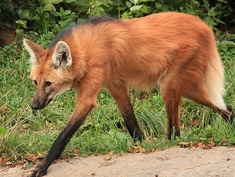
Animals of the Week #5: Brazil
First published: Saturday November 6th, 2021
Report this blog
Some More Information
Ah, Animals of the Week. Where I strive to teach you about unique, distinct animals all across the globe. One mammal, bird, reptile, amphibian, fish, and invertebrate, to satisfy all the curious minds looking for more information, and to please zoology-loving souls. Join me as we journey through the Brazilian wilderness and discover the truly amazing creatures that make their home here in A Terra do Brasil.
Mammal: Maned Wolf
Although it looks somewhat like a wolf, fox, or even a wolf-fox hybrid, this unique canid is a maned wolf, the crown jewel of Brazil's cerrado, a colossal tropical savanna. A beautiful, thick red-orange coat, slender black legs, tall ears, and a bushy tail physically define the maned wolf's characteristics. As the largest canine species in South America (primarily because the other canids on the continent are quite small), the maned wolf has been scientifically proven to be neither fox nor wolf but part of an entirely different genus, though it is part of the canine family along with wolves, foxes, dingoes, and various other wild dog species. At three feet (90 cm) tall at shoulder and approximately 50 pounds (23 kg), maned wolves are distributed all over central and eastern South America, in northern Argentina, south/central Brazil, southern Peru, Paraguay, and Bolivia. As stated before, they inhabit the vast cerrado, which is comprised of grasslands, wetlands, savannas, marshes, and wet and dry forests. The maned wolf is an omnivore, seasonally feeding on copious fruits and vegetables (particularly the lobeira, meaning "fruit of the wolf"), and on the more carnivorous side of things, the "wolf" preys on rodents, rabbits, and insects. Sharing their habitat with a variety of tough carnivores, including jaguars, cougars, bush dogs, and foxes, but since they are relatively sizable, the only animals known to kill them are cougars and domesticated dogs. Despite the International Union for Conservation of Nature (IUCN) listing them as merely Near Threatened (which is still bad, but not as bad as other statuses), other organizations deem them endangered, and it is thought that their population is around 20,000 in Brazil and only 5,000 outside of it. Hopefully, in Brazil and other nations, the maned wolf shall endure.
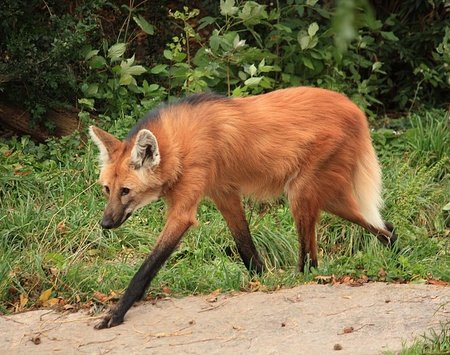
Bird: Greater Rhea
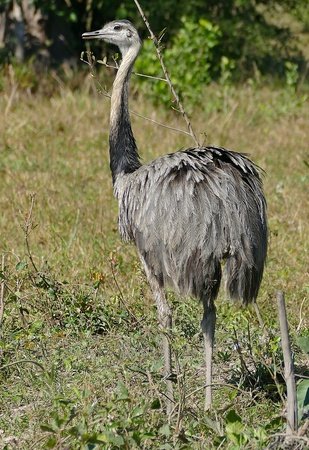
Rheas are part of a bird group that includes some familiar species: ostriches, emus, cassowaries, kiwis, extinct moas and elephant birds, and, of course, rheas. Oversimplified, this group, known as ratites, can be defined as a unique group of avians characterized by flightlessness, lengthy legs, and a typically large appearance, though this may not always apply (such as in the case of the kiwi, considerably smaller than the other ratites). Enough about the group, let's talk about the rather obscure greater rhea, South America's only flightless bird!
The greater rhea dwells in the sparse woodlands of Brazil and Argentina as well as the open pampas, which can be roughly defined as the fertile lowlands in parts of southeastern South America, which you can see in more detail on this map. Their long, vigorous legs are used to escape hazards, and their seemingly useless wings can obviously not be used to fly, but are useful when it comes to balancing and changing direction. So while the wings may seem vestigial, they actually serve some purpose. As a polygamous species, greater rheas do not mate for life and thus males have several mates throughout their existence, perhaps multiple at a time. The ratites lay their eggs in a nest designed by the male, and, somewhat peculiarly, multiple rheas will deposit their eggs in one singular nest, leading to nests of over fifty eggs. Males incubate the eggs (of all their mates) for six weeks and care for the newborn young, ferociously guarding their children against any creature - even another rhea - that comes too close for comfort. Males also live alone in the spring breeding season but the species is very sociable in the wintertime and often gathers with others of its species as well as other animals in the area, like deer and guanacos (llama relatives), which forms mixed herds. Rheas' diets consist of plants, fruit, and seeds but also digest insects, lizards, birds, and other small critters. They also feast on some agrarian crops, which can gain the unwanted ... infuriation ... of local farmers. Threats to survival include the collection of their eggs for food, the consumption of their meat, hunting to supply trade, and more, which is very detrimental to the species, which is now at a status of Near Threatened (according to the IUCN), which hopefully shan't worsen.
Reptile: Matamata Turtle
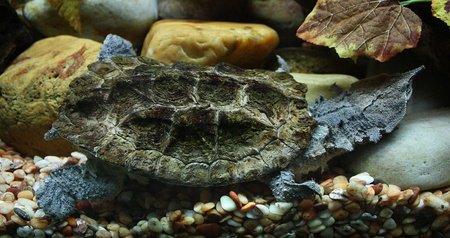
As you have definitely noticed by now, the appearance of the matamata turtle is without a doubt ... unusual. Its shell, otherwise formally known as a carapace, is evidently rough and lumpy, in addition to the ridges and bumps strewn all over its long neck. Looking at this thought-provokingly odd picture, you may notice the flat head, wide mouth, and very pointy snout of the turtle, which are some of the reptilian's several key defining features. The turtle's relatively sizeable carapace can grow to 1.5 feet (45 cm) or as heavy as 38 pounds (roughly 17 kg), which, surprising as it sounds, is equivalent to the weight of a four-year-old child!
Matamatas stretch throughout northern South America's Amazon regions, inhabiting the jungles of Ecuador, Peru, Colombia, Venezuela, Bolivia, and Brazil (obviously), as well as the Caribbean island of Trinidad.They are primarily aquatic, lurking at the soft, mud-caked bottoms of shallow and slow-moving bodies of water, like swamps, marshes, and streams, for example. The carnivorous matamata turtle's mouth is a key tool in predation, working something like a vacuum, sucking up small fish and invertebrates. Other than this "vacuum method", in terms of predatory methods, matamatas easily camouflage and remain mostly motionless, allowing for a quick, successful ambush. There is a lot more to know about this turtle's physical traits, reproductive habitats, and more, but for the sake of maintaining brevity, you can check out more here.

Amphibian: Ornate Horned Frog
When you first think of a frog, well, your imagination is limited. There are stereotypes of ordinarily colored green frogs, which are present, but many frogs have quite riveting patterns, such as the ornate horned frog. The name of this amphibian originates from the horn-like folds of skin above the eyes. Primarily spread through the tropical and mountainous rainforests of South America (particularly Argentina, Uruguay, and Southern Brazil), the ornate frog's striking color patterns serve a quite useful purpose, camouflaging the amphibian in the depths of the forest floor. When prey is near, the frog ambushes its prey, devouring it in no less than one or two gulps, earning it the nickname "Pac-Man Frog".
Adult "Pac-Man frogs" range from 3-6 inches (8-15 cm) in length, and peculiarly enough, have often the exact same width. Sizeable females can weigh up to 480 grams, or one pound. Ornate frogs gulp down insects such as earthworms, crickets, and superworms, as well as appropriately-sized mice and fish. Maturity is reached at 16-24 months of age, and the uniquely-colored frogs have a general lifespan of around 6-7 years, though they've been reported to live for much longer. That's enough about Brazil's flamboyant frog species, let's move on to one of the most interesting cases of an invasive species ...
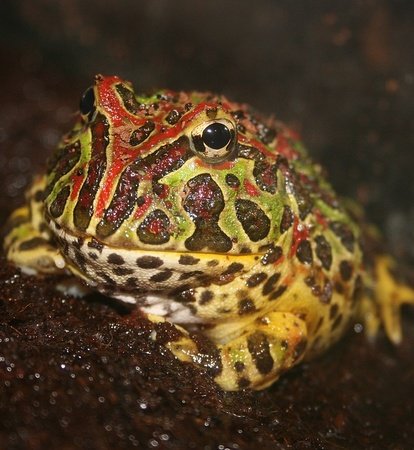
Fish: Pacu
rUnlike most of the features in this series, pacu is not a speciifc species, but rather a general name that is commonly used to refer to several species of omnivorous South American freshwater fish - that happen to be a very invasive species. Closely related to piranhas, pacu vary from their cousins in jaw alignment, diet (pacu are primarily vegetarian and mainly feast on floral material rather than fish or scales), and length; pacu can reach up to 1.08 meters in length (roughly 3.55 feet) and 40 kilograms (88 lbs) in terms of weight. Originally, the pacu is native to tropical and subtropical regions of South America - rivers, lakes, floodplains, and flooded forests - in rivers such as the Amazon, Orinoco, and Sao Francisco, as well as the Rio de la Plata basin. Preferences of habitats vary depending on the species, and several pacu species are migratory. But perhaps the most interesting aspect of the pacu is its widespread range throughout the world.
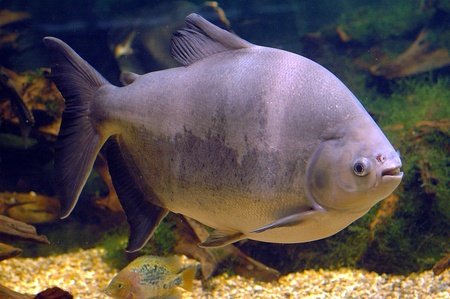
Pacu have been discovered in (wait for it) ... thirty-six out of fifty states of the U.S. (thirty-seven if you count Puerto Rico), which is completely wild to contemplate. They are common all over Europe, first being caught in August 2013 in the Oresund strait between Denmark and Sweden, which has kickstarted a series of uncanny discoveries all around Europe. Pacu have been caught in the Seine River in Paris (2013); a city pond in Tula, Russia (2016); during a fishing contest in a Romanian river port, which happened by accident (2017); the Motala Strom river system in Norrkoping, Sweden (2017); the vicinity of Baia Mare, Romania (2019); and finally, in September 2020, the Zegrze Reservoir in Poland heralded a pacu weighing seven pounds, or three kilograms. Pacu have also become well-established in tropical Asia, in India and Thailand.
The final place that pacu have been sighted in is in New Guinea, blamed by indigenous to have outcompeted juvenile crocodiles and attacking humans. The species was actually introduced to the Sepik River in 1994 and the Ramu in 1997 as a food source after the intense overfishing of native species. There are also tales of the pacu attacking a certain part of the male human body, and though experts doubt this and deem it a myth, it is unconfirmed whether it is true or not.
Conclusion
Well, folks, it's finally done. I feel ashamed for waiting 75 days to finish this edition of Animals of the Week, but hopefully after this blog the posts will become more frequent (the RUB really needs it). I hope you enjoyed my shedding light on the unique wildlife of Brazil, and remember: this series highlights idiosyncratic, sometimes obscure species, some that I wouldn't expect so many people to know about. How many of these animals have you heard of? Any suggestions for future thematic AOTW blogs? Inform me on that, as well as your thoughts! It's been a long time, and I want to know if people still appreciate my blogs. With that said, I've got an endless amount of ideas for new thematic Animals of the Week blogs, but I'll let you vote on three options. Do you want to see a blog about animals of Australia and New Zealand, China and East Asia, or the polar regions of the world? Let me know! I'll see you in my next blog!
P.S. I left out the invertebrate section because I wanted to release this blog as soon as possible, and, in all honestly, I didn't want to write about the bullet ant (call me lazy, but this is my blog).

1st Place: Australia and New Zealand - 3votes
Polar Regions - 3 votes
3rd place: China and East Asia - 2 votes
Was waiting for ARARAS or TUCANOS, or even the CANÁRIO, not EMAS actually, and thanks for the LOBO-GUARÁ! We cannot mention all Brazilian animals, because our fauna is surely the most diverse of the world. But thanks for it! BRASIL-SIL-SIL! 🇧🇷
Maybe I’m gonna vote for China and East Asia.
Maybe a bit peeved at the fact that you didn't know themOk, thanks for the vote.
Maybe MG can helpAs for the next AOTW, I'll vote for Australia and New Zealand.
NOW VOTE VOTE VOTE